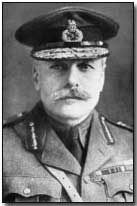Who's Who - Sir Douglas Haig
 Sir Douglas Haig (1861-1928), the most
controversial of the war generals, was born in Edinburgh on 19 June 1861.
Sir Douglas Haig (1861-1928), the most
controversial of the war generals, was born in Edinburgh on 19 June 1861.
He studied first at Brasenose College, Oxford, and then in 1884 at the Royal Military Academy (Sandhurst).
He passed out of Sandhurst in under a year, joining the 7th (Queens Own) Hussars. He served there as a cavalry officer for the following nine years, chiefly in India.
Haig took part in the Omdurman campaign of 1897-1898, and in the Second Boer War of 1899-1902, where he served under Sir John French.
In 1906 Haig became Director of Military Training at the war office. Part of Haig's responsibility during this time included the construction of the British Expeditionary Force (BEF) for deployment in the eventuality of war with Germany.
In 1909 Haig was made Chief of Staff of the Indian army.
By August 1914 - the start of the First World War - Haig commanded 1st Army Corps within the BEF as Lieutenant General. At this time the BEF was under the control of Sir John French. Haig's 1st Army Corps served with distinction at Mons and at First Ypres.
By the close of 1915 it was clear that French was ill-suited to the nature of the campaign, often depressed and pessimistic about the chances for success. Consequently Haig was appointed the new Commander in Chief of the BEF on 10 December 1915, a position he took up nine days later, French returning to Britain as Commander of the British Home Forces.
Much of the nature of the fighting taking place in the First World War was alien to Haig, a cavalry man through and through. He did not rate very highly the war's new weaponry. "The machine gun is a much over rated weapon," he said in 1915; he made similar remarks over the use of the tank.
The Somme offensive with which Haig's name is most often associated (along with Third Ypres, also known as Passchendaele), began on 1 July 1916. Haig was pressured to bring forward the original attack date from August so as to relieve the heavy casualties experienced by the French at Verdun, which the Germans had been bombarding since early in the year.
It was thought that by committing significant British forces on the Somme, the Germans would necessarily divert troops from Verdun, thereby taking the sting out of the offensive.
The first day of the Battle of the Somme saw the British Army suffer the highest number of casualties in its history: 60,000. Whether the attack was a success or not remains an area of controversy: however most historians agree that the cost in human terms was too high for relatively little gain. In any event the offensive was called off by Haig on 18 November 1916, technically a British victory.
1917 saw the campaign at Third Ypres from July to November - Passchendaele - which ultimately ground down German resistance, although at heavy cost in British manpower.
In 1918 Haig oversaw the successful British advances on the Western Front which led to victory for the Allies in November.
Haig has been criticised by many over the years for his tactics, which it is argued were deeply flawed. The wartime Prime Minister, David Lloyd George, was one such critic. He wrote that he sometimes wondered whether he should have resigned on more than one occasion rather than permit Haig to continue with his strategy. On the other hand, it is suggested that Haig's hand was largely forced by the pressure placed by the French for constant relief on the Western Front, on the Somme in 1916 and at Passchendaele in 1917.
After the armistice Haig served as Commander in Chief of the British Home Forces until 1921, the year of his retirement. His recent predecessor in this role was Sir John French. Haig was also awarded a grant of £100,000 by the government. He was made an earl in 1919 and then Baron Haig of Bemersyde in 1921.
Haig dedicated the remainder of his life to service in the Royal British Legion (which he helped to establish), caring for the welfare of the troops who served under him during the war.
Sir Douglas Haig died on 28 January 1928.
Click here to read Sir Douglas Haig's wartime despatches.
A 'Toasting Fork' was a bayonet, often used for the named purpose.
- Did you know?
